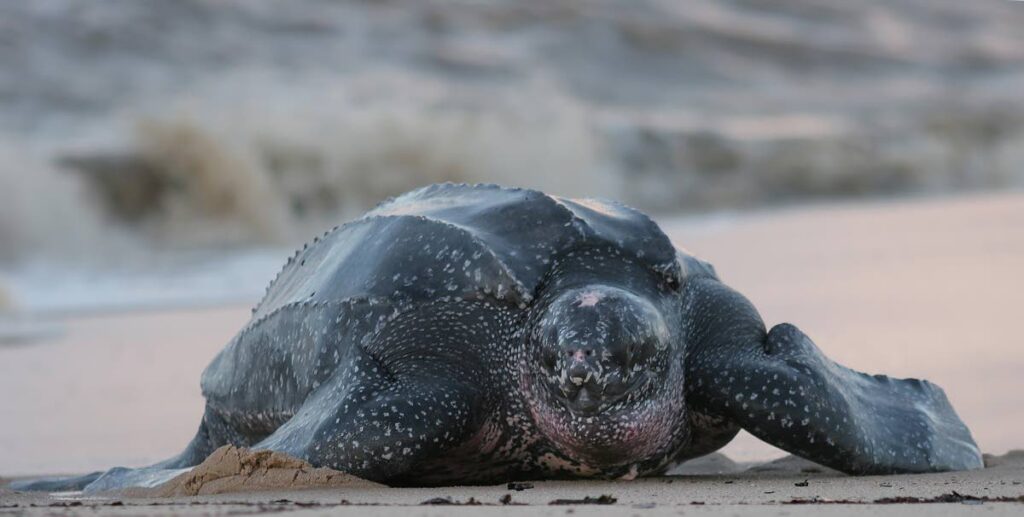Looking for leatherbacks

Today, we introduce Green Readers by Julie Morton, a new feature of stories with easy-to-answer questions, all meant to help you learn about our environment and animals. So have fun reading.
It was dark, the moon and stars hidden by low clouds. At his side was Amanda. She had come from many miles away, from a city in Australia, called Perth, all the way to Matura, Louis’s village in Trinidad.
“I have heard about the leatherback turtle,” she had said to Louis.
“I want to see one, and would you tell me all that you know about them?” she asked.
They had come upon their first leatherback turtle at about ten o’clock that night. There it was, just ahead of them, looking like a large rock on the sand.
Amanda was so excited.
It was so large. Dark and mysterious looking, it was moving slowly up the beach towards the coconut trees on the shoreline.
“Sit down,” said Louis quietly.

“This will take some time. You are about to see one of the greatest shows on earth.”
The leatherback slowly inched its way up the shore to stop just short of the trees, where the sand was coarse and dry. As her eyes grew used to the darkness, Amanda could see the turtle’s four flippers working in unison to dig the deep hole where she would lay about 60 to 80 eggs.
It was more than an hour before the turtle was satisfied with the nest she was preparing for her babies.
Amanda watched in amazement as she began to lay her eggs. When the moon shone briefly through the dark clouds, Amanda could see the tears slowly falling from the turtle’s eyes as she laboured to lay her many eggs.
“Would you like to hold one of her eggs?” said Louis.
“She won’t mind.”
Amanda said yes, and Louis reached into the nest to lift out an egg.
She held out her hand and Louis carefully placed the egg on the palm of her hand. It was soft and warm and as large as a golf ball. Amanda felt as though she held life in her hand.
Turtles have inhabited the Earth for more than 60 million years, she thought, even before the dinosaurs.
Louis reached for the egg and returned it to the nest.
“There is still much to learn about the leatherback,” Louis was saying, “but we know that every female turtle hatched here, that survives to become an adult, comes back to this beach to lay her eggs.”

When the last egg was laid, the magnificent leatherback started closing her nest, safely covering up the eggs. The task was just as long and difficult, and it was an hour or so before she was finished.
“Watch carefully now,” said Louis, as the turtle seemed to do a dance on the sand and turning headed quickly down the beach.
“Where is the nest?”
Amanda took her last look as the turtle disappeared into the darkness of the sea and turned to find the nest. Where indeed? She had been so clever, that mother turtle. She had swept the sand so it looked just as it had before.
Where was the nest?
“I don’t know,” said Amanda.
“What happens now?” she asked, as they walked back along the beach.
“In about three months time, the eggs will hatch,” said Louis, “those that were not dug up by men or dogs.
The baby turtles are smaller than your hand. As they push their heads out of the sandy nest, they head straight for the sea.
Some of them, however, never reach the sea. They are eaten by animals or birds, or by crabs, and in the sea, by fishes. Very few survive. Those that do, seem to head for the Sargasso Sea, where we think they spend the first year of their lives,” said Louis.
As they walked, Amanda saw four more turtles coming ashore to lay their eggs, and Louis told her of the time when he would walk along the beach for a week and not see a single turtle.

“Hunters were killing them for meat and for their flippers. Now with the help of wildlife game wardens, the people of our village patrol the beach to protect the turtles. It seems to be working, as we no longer see dead turtles on the beach and more of them now come ashore to lay eggs,” he said.
“Do you think your turtles travel as far as Australia?” asked Amanda.
“Who knows?” said Louis.
“Leatherbacks are great travellers. They swim as far north as Canada and the Arctic, across the Atlantic to Norway, then south again to Africa.
“Maybe they do.”
Some easy questions to answer
1. When did Amanda see her first
turtle?
2. Describe how the leatherback made
its nest.
3. How many eggs does a leatherback
lay?
4. Why do you think tears fall from the
leatherback’s eyes?
5. Which came first, the turtle or the
dinosaur?
6. How does the leatherback hide its
nest?
7. How big are the baby turtles?
8. Who are the turtles’ enemies?
9. Where do the baby turtles live in the
first year of their lives?
10. How do wildlife game wardens
protect the turtles?
Write some reasons why you should protect the wildlife of your country. Write a story about an endangered animal, which you helped protect from a hunter.


Comments
"Looking for leatherbacks"